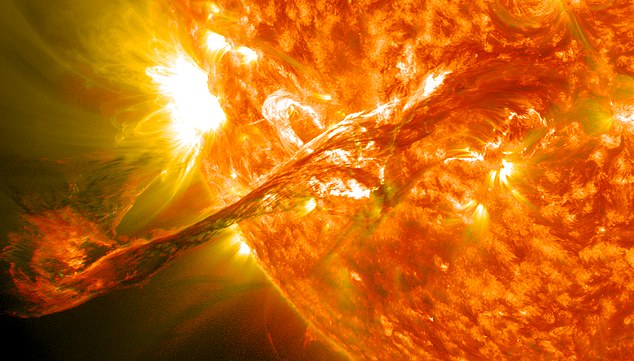The Earth will be devastated by a geostorm that could cause power outages. Here’s what you should brace yourself for
Earth is preparing for an extreme geomagnetic storm this week after the sun blasted a massive solar flare toward our planet this week.
Sunspot AR3842 — a dark, fast-growing region of strong magnetic fields on the Sun’s surface — erupted around 6 p.m. ET Tuesday evening, producing the second-strongest solar flare in the past five years.
The eruption has already caused a shortwave radio disturbance over Hawaii and shot a coronal mass ejection (CME) – an explosion of solar plasma and high-energy particles – into space.
The National Oceanic and Atmospheric Administration (NOAA) predicted that the CME will collide with Earth early to mid-day on October 5.
The collision could trigger a strong geomagnetic storm that could cause radio interference, damage to the power grid and disruptions to satellite communications.
NASA’s Solar Dynamics Observatory captured this image of the solar flare that erupted on October 1, 2024, visible as the bright flash in the lower left
Solar flares are powerful bursts of radiation that result from the release of magnetic energy associated with sunspots. They are the largest explosive events in the solar system.
Tuesday’s eruption was an X7.1, according to NASA.
X is the largest class of solar flares, which can cause radio disruptions and widespread damage to satellites, spacecraft and power grids around the world.
It is followed by the M, C and B classes in decreasing order of severity. Within each letter class there is a finer scale from one to nine that further specifies the intensity of the flare.
This was the second largest solar flare since the sun entered its 25th recorded solar cycle in December 2019.
The solar cycle refers to the roughly eleven-year cycle of solar activity driven by the sun’s magnetic field.
The sun’s activity fluctuates during this cycle, becoming more active during solar maximum – the stage we are currently in – and less active during solar minimum.
The largest eruption of this cycle so far occurred in May, when an X8.9 flare erupted from the Sun’s surface.

Solar flares can cause coronal mass ejections (CMEs). A CME is currently hurtling towards our planet at almost 1,300 kilometers per second

When CMEs impact our planet, they can cause blinding auroras. But they can also significantly disrupt and damage communications and energy infrastructure
Tuesday’s sent radiation through Earth’s magnetosphere, ionizing the upper atmosphere and causing a temporary radio blackout over a wide area over the Pacific Ocean, including over Hawaii.
It also sent a CME towards Earth at hundreds of kilometers per second. NASA predicts that this blast of solar radiation will hit our planet sometime between Saturday and Sunday spaceweather.com.
When CMEs affect Earth’s magnetosphere — the region of space around our planet that is dominated by its magnetic field — they can cause large disturbances called geomagnetic storms.
Geomagnetic storms can produce blinding aurora displays at unusually low latitudes, and there’s a good chance we’ll see some this weekend as well.
But like solar flares, they can also cause radio interference, disrupt satellite communications and damage power grids.
The impact of this storm will depend on how strong it is. Geomagnetic storms are classified on a scale from G1 (small) to G5 (extreme).
More severe storms are rarer, produce more widespread auroras, and have a greater effect on Earth’s infrastructure.
It is currently unclear exactly when this weekend’s geomagnetic storm could hit and how strong it will be.
But NOAA experts have issued a G1 to G3 geomagnetic storm watch for Thursday, October 3 through Saturday, October 5, with the most likely timing of the CME’s impact planned for Saturday.
This week’s solar activity adds to mounting evidence that the sun has reached solar maximum, the period during its eleven-year cycle when solar activity is at its peak.
In 2019, scientists predicted that solar maximum would begin around July 2025. But as the sun’s activity increased over the course of 2024, it became clear that this peak would come much sooner than expected, prompting experts to revise their prediction.
The sun has already shot 41 X-class solar flares this year. According to spaceweather.com, that’s more than in the past nine years combined.
In an average year, class X solar flares occur only about 10 times.
Solar maximum could last at least another year, so we can expect many more intense solar flares, CMEs, and geomagnetic storms to hit our planet in 2025.
